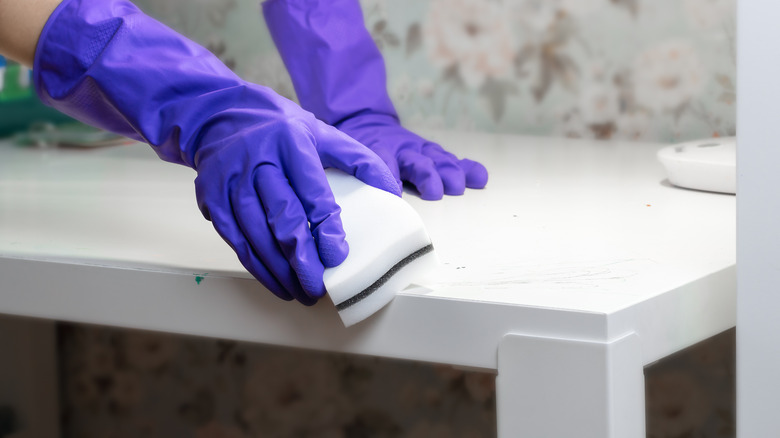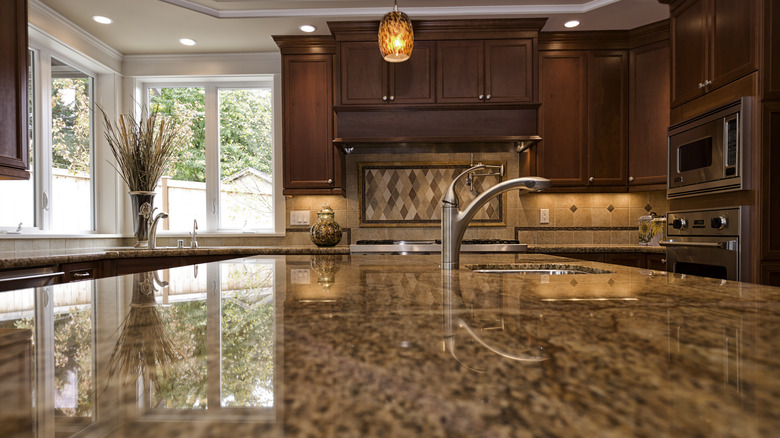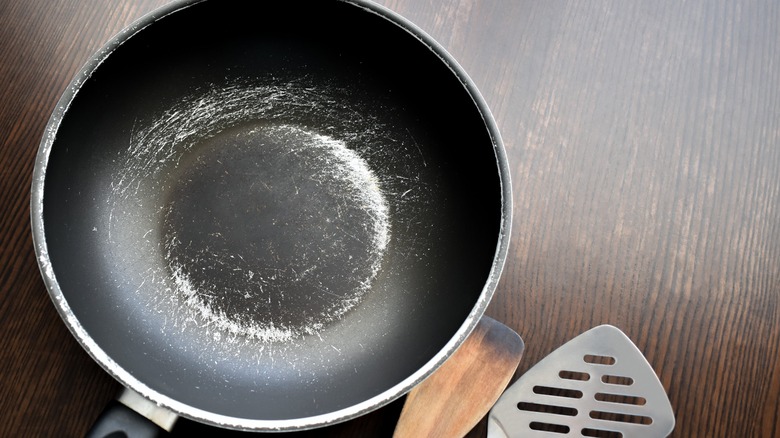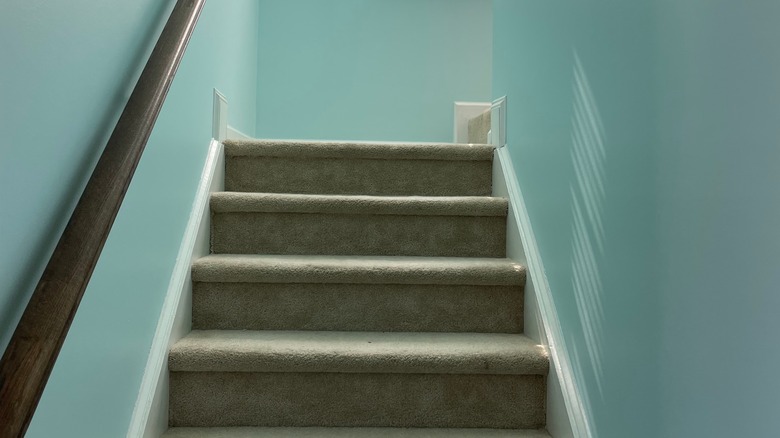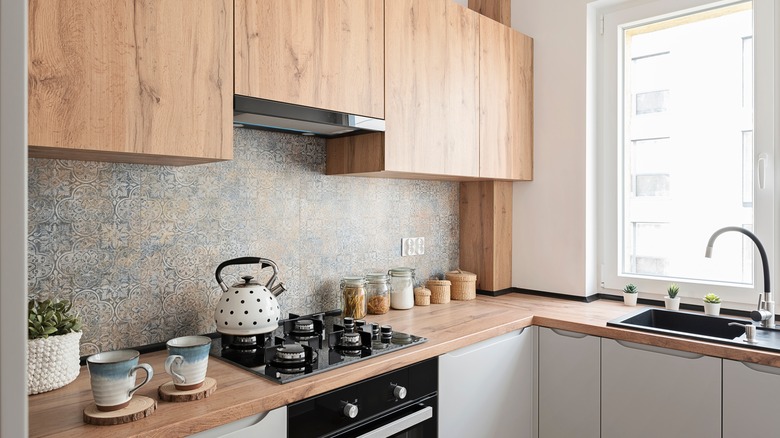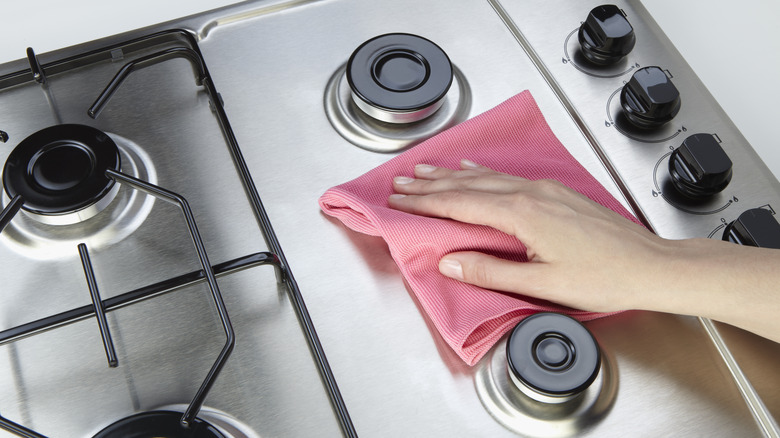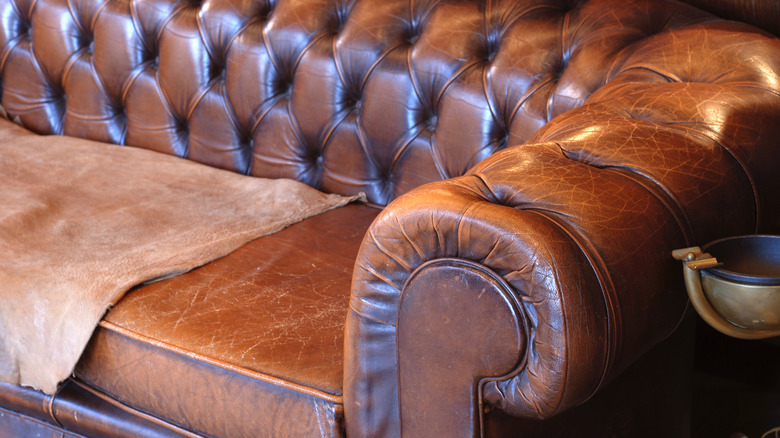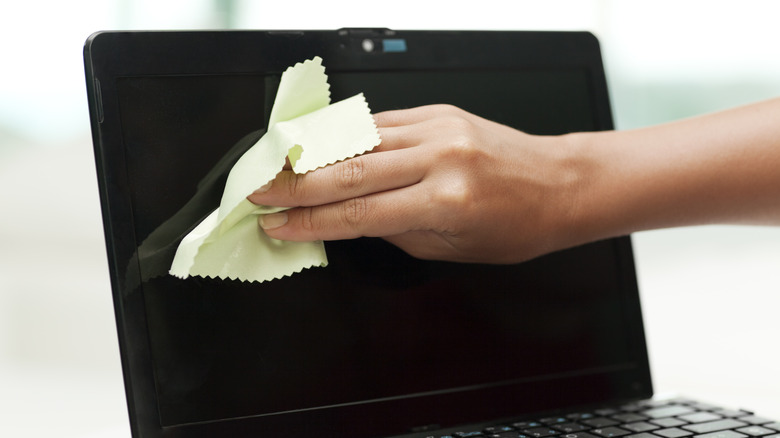Places In Your Home To Avoid Using A Mr. Clean Magic Eraser
We may receive a commission on purchases made from links.
In the realm of household cleaning, Mr. Clean Magic Erasers have gained a reputation as a one-size-fits-all product for tackling various stains and marks. These cleaning pads, composed of melamine foam, work through micro-abrasion to lift away dirt and grime from a multitude of surfaces. Whether it's scuff marks on walls, stubborn stains on countertops, or traces of crayon on furniture, Magic Erasers seem like an almost magical solution to a range of cleaning woes.
However, while they do a great job of removing stains, it's essential to exercise caution and discernment when deciding where to wield these powerful cleaning tools. While these sponges might seem to be soft and squishy, they are actually very abrasive, with effects comparable to sandpaper. There are many situations where they are actually too effective in removing mess, and as a result, they accidentally remove other things like paint and finishes. Here is a list of the places in your home where using a Magic Eraser might be less than ideal and potentially detrimental.
Marble and granite countertops
Marble and granite are two of the most popular types of countertops for good reason. Not only are they beautiful and natural-looking, but they have a reflective finish that makes them look elegant. If you want to keep your countertops in pristine condition, you might be tempted to buff out a small scratch or stain with a Magic Eraser, but this will only make things worse. The abrasive nature of the eraser will wipe away the countertop's sealant along with any stain, taking away its shiny finish. The result will be a dull splotch that reflects light unevenly.
With marble and granite typically used in high-traffic areas like the kitchen or bathroom, needing to clean them is inevitable. So, how do you do so safely? "In general, cleaning marble with mild dish detergent and warm water is a safe bet," explained Marla Mock, president of Molly Maid, in an interview with Martha Stewart. If you have a tough stain, Mock says you can create a spot treatment using baking soda and water. Combine the two ingredients and spread the paste on the stain. Cover with plastic wrap, leave it for a full day, and wipe it clean. However, this is best used on a fresh stain rather than one that has dried and set. If you have dried stains, you most likely will need to reach out to a marble manufacturer to have them buff and reseal the area.
Non-stick pans
If you have a burnt-on mess to clean up after a big dinner, it might be tempting to use a Magic Eraser as a quick fix. Not only will its slight abrasiveness help slough off the stubborn grease, but there is also the Magic Eraser Kitchen with Dawn version, which seems tailor-made for dishes. However, this doesn't work for all cookware, and the Mr. Clean website specifically says not to use the sponge on pots and pans with non-stick coating. This is because the abrasive nature of the sponge will scrub off not only food residue but also the non-stick layer. This scratched-off coating can result in small particles of Teflon and microplastics making their way into your food. These microparticles are definitely not something you want to eat, as they are linked to health risks, including a higher risk of cancer, as per a groundbreaking study published in "Environmental Health Perspectives."
To avoid this, you don't need to throw away all your non-stick cookware. You just have to take a little extra care when washing up. Stick to the classic dish soap and non-abrasive sponge to clean up the majority of messes. If this method isn't cutting it and you need more power than elbow grease alone, fill up the pot or pan with water. Add in ½ a cup of distilled white vinegar and bring the mixture to a boil. Allow the pot to cool, and then dump out the water. This should make cleaning the rest of the mess with dish soap and a soft sponge much easier.
High gloss finishes
High gloss paint is known for its highly reflective appearance, which gives off a clean, contemporary look. It is known to be tough and stain-resistant, making it a prime choice for kitchens, bathrooms, and doors and cabinets. You might think that with this paint's durable reputation, a Magic Eraser wouldn't do much damage. But even high gloss finishes are prone to scratches and abrasions, and using a Magic Eraser could potentially dull or scratch its surface, resulting in visible damage. There is a possibility of the eraser removing not just the stain but also a layer of the paint itself, leading to uneven patches.
Instead of relying solely on a Magic Eraser, consider using a soft, damp cloth or sponge with a mild cleaning solution as a gentler alternative. You will help preserve the integrity of the paint finish if you start with the least abrasive method and only escalate to a Magic Eraser if no other methods are working. It is crucial to conduct a test in an inconspicuous area first to assess any potential damage or changes to the finish.
Wooden surfaces
Similar to the effects on high gloss paint, if a Magic Eraser is used on wooden surfaces, it can potentially scratch or damage their finish or sealant. They may not withstand the abrasive action of the eraser, leading to visible marks and an uneven look. Even if you are gentle, the cleaning agents present in Magic Erasers may react with certain wood finishes, resulting in discoloration or changes to the sheen. That's why the brand itself recommends not using the eraser on untreated or polished wood.
To maintain the beauty and longevity of your wood surfaces, it's best to keep it simple and gentle. The best method is to use a gallon of warm water with just a few drops of natural dish soap. Ensure your mop or microfiber cloth is only damp and not wet when cleaning the surface since standing water can damage, discolor, or warp the look. You also want to wipe it dry once you're done to ensure nothing is oversaturated. If there is a stubborn stain, use a cloth or sponge to clean it, possibly adding a little more soap to help lift the mark. However, you want to avoid using stuff like vinegar or lemon since that can damage the finish, much like a Magic Eraser would.
Stainless steel
Stainless steel is beautiful and sleek. Whether it's a stainless steel fridge or a nice set of cookware, people love incorporating this material into their homes. The only downside is that grease and dirt can cling to its surface and be extra visible, but don't grab your Magic Eraser for an easy fix. According to the brand Mr. Clean itself, the eraser is not suitable for cleaning that specific material. The abrasive texture of the sponge can possibly create tiny scratches on the stainless steel, marring its appearance.
Luckily, you can achieve clean and sparkling stainless steel with many other methods, like using a soft microfiber cloth or gentle sponge. Warm water and mild dish soap or white vinegar are the way to go if you want to keep your kitchen in prime condition. If you want something stronger, specially formulated stainless steel polish will bring out the best in your surfaces. This one from Weiman has a pH-neutral formula that will easily cut through any fingerprints, which is always one of the biggest issues with stainless steel appliances.
Leather upholstery
One of the best parts about investing in leather furniture is that if you take care of it, it only gets more personality as it ages. Buying a piece of furniture for the long haul means committing to cleaning it, but leather can be a bit tricky since it's a natural material. That means it can be sensitive to abrasive cleaning tools, and scrubbing with the melamine eraser may cause scratches, scuffs, or dulling of the material, diminishing its appearance over time. It can also strip away the protective finish wherever you use the sponge, making the exposed leather more susceptible to future stains. This, of course, is the exact opposite of how you want your leather furniture to age. However, if you must use it, it's best to use it on either light-colored leather (since scratches and dull spots won't be as noticeable) or already distressed leather.
Instead, it's best to use an upholstery attachment on a vacuum to routinely remove dust and dirt from the furniture's surface. If it requires a deeper clean, use a microfiber cloth and a specialty leather cleaner to remove built-up dirt. Such an example is the Weiman Leather Cleaner and Conditioner for $12 on Amazon. Spray it onto your cloth rather than the couch to avoid oversaturating the material, which can lead to water marks, and if your cleaner isn't formulated with a conditioner, make sure to add that afterward so the skin doesn't dry out. If you're tackling a stain, a microfiber cloth dipped in warm water and a drop of dish soap will do just the trick.
Car exterior
Your car can be one of the dirtiest things you own. From mud caked on the side to bugs squished against the grill, it is very tempting to use a disposable Magic Eraser to wipe away all the gunk and be done with it. However, this is one of the worst things you can do for your car in the long run. All vehicles have a clear protective coat. This is a vital layer for preserving the paint's color, protecting against environmental elements and rogue scratches, and contributing to long-term durability and resale value. Using an abrasive Magic Eraser can jeopardize this protective coating and can even scratch the paint underneath it. Once you damage the paint, you introduce the risk of rust developing on the vehicle.
To avoid all of this, stick to using the Magic Eraser on the inside of your car since it works great for places like cupholders and the center console. To clean your car's exterior, the simplest solution is to use water and soap formulated for car exteriors, such as M.A.X. Power Wash, which you can get at places like Target for $7.50. Use a microfiber cloth or a soft wash mitt to avoid knicking the sealant like the abrasive Magic Eraser would.
Laminate furniture or cabinets
Laminate furniture and cabinets are great choices for high-traffic homes since they are more resistant to spills and moisture than natural wood. However, opinions on whether it is okay to use a Magic Eraser on laminate are split. The Mr. Clean website claims that laminate is one of the surfaces that the brand recommends cleaning with the eraser, but many users online have posted pictures of their scratched laminate surfaces, claiming that the Magic Eraser ruined them.
Here is the deal. While it is okay to use a Magic Eraser to buff out small scuffs or sticky stains, you don't want to make this a regular part of your cleaning routine. If you use the Magic Eraser often or scrub too hard and for too long, it will remove the sheen and eventually strip the paint on your item. Remember, it acts very similar to fine-grit sandpaper. If you want a better way to clean your laminate long-term, use warm water and dish soap. If tackling a stain, use a mild all-purpose cleaner and a soft bristle brush, which will give you slightly more scrubbing power. If it's a really tough stain, you can also use a tiny bit of baking soda to add some grit, but it will act similarly to the Magic Eraser and could potentially dull the sheen or remove the paint.
Screens on your electronics
Seeing what feels like thousands of specs of dust on your screen is frustrating, but using a Mr. Clean Magic Eraser on electronic devices like smartphones, tablets, or computer monitors, is not the answer. Many electronic screens have special coatings that provide features like anti-reflective properties or smudge resistance. The abrasive nature of a Magic Eraser can potentially damage or remove these coatings, leading to a loss of functionality and clarity.
It's recommended to clean electronic screens with a soft, microfiber cloth designed for screens and a gentle cleaning solution specifically formulated for electronic devices. You can even buy this electronic cleaner in a convenient wipe version, like these Weiman Disinfecting Electronic Cleaning Wipes available on Amazon. These wipes are designed to clean off any dirt and dust while also sanitizing the electronics that we touch dozens of times a day. There will be no streaky residue left over, as many other cleaning products not formulated for electronics will leave.

